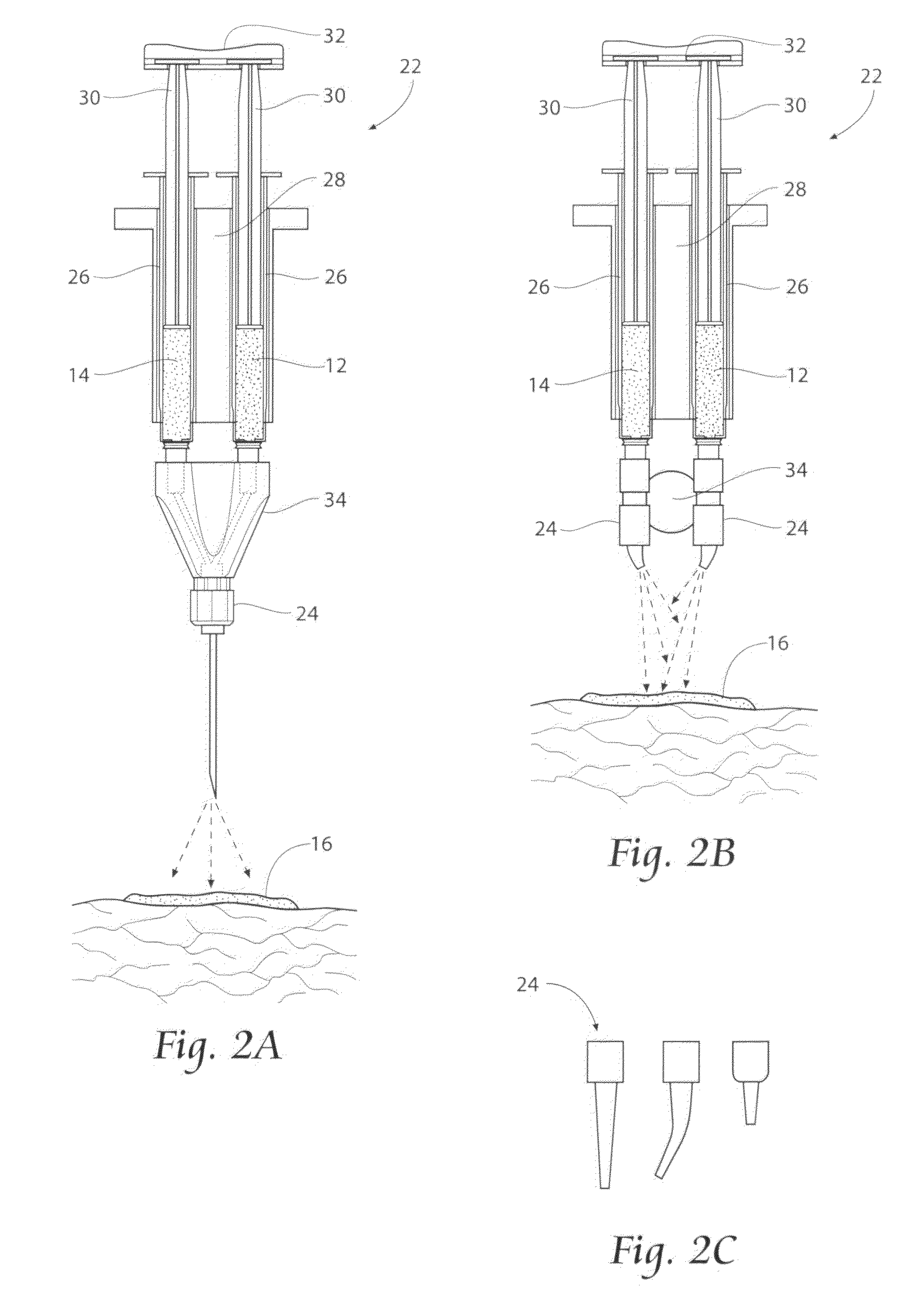Wound treatment systems, devices, and methods using biocompatible synthetic hydrogel compositions
a biocompatible and hydrogel technology, applied in the direction of drug compositions, veterinary instruments, aerosol delivery, etc., can solve the problems of engraftment (failure of skin grafts), intraoperative blood loss, lack of hemostasis, etc., and achieve the effect of delaying the gelation process
- Summary
- Abstract
- Description
- Claims
- Application Information
AI Technical Summary
Benefits of technology
Problems solved by technology
Method used
Image
Examples
example 1
PEG-SG and Poly-L-Lysine Hydrobromide
[0090]Preparation of the electrophilic component: A weight of 0.25 g of 4-Arm PEG-SG (M / W 10,000 g / mole) is added to a volume of 1.25 cc of water for injection (WFI), and mixed. No buffering material is added. One (1) cc of the resulting WFI / PEG-SG solution is housed in a sterile dispensing syringe.
[0091]Preparation of the nucleophilic component: A weight of 0.20 g of Poly-L-Lysine hydrobromide (M / W of about 30,000 to greater than 70,000 g / mole) are added to a volume of 1.25 cc of HPLC-grade water (pH 9.73, with tris (hydroxymethyl)aminomethane buffer material), and mixed. One (1) cc of the HPLC Water / Poly-L-Lysine hydrobromide solution is housed in a sterile dispensing syringe.
[0092]Mixing of the components / gelation: A volume of 1 cc of the prepared electrophilic component is mixed with a volume of 1 cc of the prepared nucleophilic component (total mixed volume=2 cc). The accumulating gel strength G′ (Pascals) of the mixture over time is measure...
example 2
PEG-SG and Blend of PEG-Amine and Poly-L-Lysine Hydrobromide
[0094]Preparation of the electrophilic component: A weight of 0.25 g of 4-Arm PEG-SG (M / W 10,000 g / mole) is added to a volume of 1.25 cc of water for injection (WFI), and mixed. No buffering material is added. One (1) cc of the resulting WFI / PEG-SG solution is housed in a sterile dispensing syringe.
[0095]Preparation of the nucleophilic component: A weight of 0.13 g of PEG-Amine (M / W 10,000 g / mole) and a weight of 0.03 g of the Poly-L-Lysine hydrobromide (M / W 4,000 to 15,000 g / mole) are added to a volume of 1.25 cc of HPLC-grade water (pH 9.72, with tris (hydroxymethyl) aminomethane buffer material), and mixed. One (1) cc of the HPLC Water / PEG-Amine / Poly-L-Lysine hydrobromide solution is housed in a sterile dispensing syringe.
[0096]Mixing of the components / gelation: A volume of 1 cc of the prepared electrophilic component 12 is mixed with a volume of 1 cc of the prepared nucleophilic component (total mixed volume=2 cc). The ...
example 3
Comparison to Conventional Fibrin Adhesive
[0099]The graphs shown in FIG. 9 show the accumulating gel strength G′ (Pascals) of conventional fibrin adhesive (Baxter Healthcare Corporation) measured over time on an AR2000EX Rheometer (2% strain, in oscillation mode frequency 1 Hz fast oscillation mode, 10 data points per second, time sweep, 25 mm plate, 1.5 mm gap, at 25-degrees C.).
[0100]The graphs shown in FIG. 10 compare the accumulation of gel strength G′ (Pascals) of conventional fibrin adhesive (Baxter Healthcare Corporation) to the accumulation of gel strength G′ (Pascals) of the PEG-SG and Poly-L-Lysine Hydrobromide composition of Example 1. The graph of FIG. 10 shows that the composition of Example 1 has adhesive properties and cohesive properties superior to conventional fibrin adhesives.
PUM
| Property | Measurement | Unit |
|---|---|---|
| volume | aaaaa | aaaaa |
| weight | aaaaa | aaaaa |
| pH | aaaaa | aaaaa |
Abstract
Description
Claims
Application Information
 Login to View More
Login to View More - R&D
- Intellectual Property
- Life Sciences
- Materials
- Tech Scout
- Unparalleled Data Quality
- Higher Quality Content
- 60% Fewer Hallucinations
Browse by: Latest US Patents, China's latest patents, Technical Efficacy Thesaurus, Application Domain, Technology Topic, Popular Technical Reports.
© 2025 PatSnap. All rights reserved.Legal|Privacy policy|Modern Slavery Act Transparency Statement|Sitemap|About US| Contact US: help@patsnap.com



